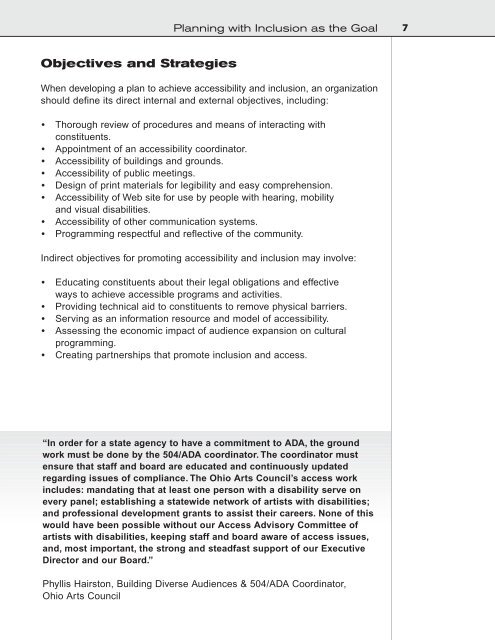Design for Accessibility: A Cultural Administrator's Handbook
Design for Accessibility: A Cultural Administrator's Handbook
Design for Accessibility: A Cultural Administrator's Handbook
Create successful ePaper yourself
Turn your PDF publications into a flip-book with our unique Google optimized e-Paper software.
Planning with Inclusion as the Goal 7<br />
Objectives and Strategies<br />
When developing a plan to achieve accessibility and inclusion, an organization<br />
should define its direct internal and external objectives, including:<br />
• Thorough review of procedures and means of interacting with<br />
constituents.<br />
• Appointment of an accessibility coordinator.<br />
• <strong>Accessibility</strong> of buildings and grounds.<br />
• <strong>Accessibility</strong> of public meetings.<br />
• <strong>Design</strong> of print materials <strong>for</strong> legibility and easy comprehension.<br />
• <strong>Accessibility</strong> of Web site <strong>for</strong> use by people with hearing, mobility<br />
and visual disabilities.<br />
• <strong>Accessibility</strong> of other communication systems.<br />
• Programming respectful and reflective of the community.<br />
Indirect objectives <strong>for</strong> promoting accessibility and inclusion may involve:<br />
• Educating constituents about their legal obligations and effective<br />
ways to achieve accessible programs and activities.<br />
• Providing technical aid to constituents to remove physical barriers.<br />
• Serving as an in<strong>for</strong>mation resource and model of accessibility.<br />
• Assessing the economic impact of audience expansion on cultural<br />
programming.<br />
• Creating partnerships that promote inclusion and access.<br />
“In order <strong>for</strong> a state agency to have a commitment to ADA, the ground<br />
work must be done by the 504/ADA coordinator. The coordinator must<br />
ensure that staff and board are educated and continuously updated<br />
regarding issues of compliance. The Ohio Arts Council’s access work<br />
includes: mandating that at least one person with a disability serve on<br />
every panel; establishing a statewide network of artists with disabilities;<br />
and professional development grants to assist their careers. None of this<br />
would have been possible without our Access Advisory Committee of<br />
artists with disabilities, keeping staff and board aware of access issues,<br />
and, most important, the strong and steadfast support of our Executive<br />
Director and our Board.”<br />
Phyllis Hairston, Building Diverse Audiences & 504/ADA Coordinator,<br />
Ohio Arts Council


